
A calliope is an American and Canadian musical instrument that produces sound by sending a gas, originally steam or, more recently, compressed air, through large whistles—originally locomotive whistles.

A player piano, also known as a pianola, is a self-playing piano with a pneumatic or electro-mechanical mechanism that operates the piano action using perforated paper or metallic rolls. Modern versions use MIDI. The player piano gained popularity as mass-produced home pianos increased in the late 19th and early 20th centuries. Sales peaked in 1924 and subsequently declined with improvements in electrical phonograph recordings in the mid-1920s. The advent of electrical amplification in home music reproduction, brought by radios, contributed to a decline in popularity, and the stock market crash of 1929 virtually wiped out production.
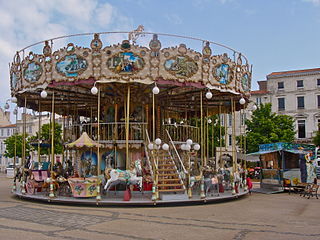
A carousel or carrousel, merry-go-round (international), or roundabout is a type of amusement ride consisting of a rotating circular platform with seats for riders. The "seats" are traditionally in the form of rows of wooden horses or other animals mounted on posts, many of which are moved up and down by gears to simulate galloping, to the accompaniment of looped circus music.

A piano roll is a music storage medium used to operate a player piano, piano player or reproducing piano. Piano rolls, like other music rolls, are continuous rolls of paper with holes punched into them. These perforations represent note control data. The roll moves over a reading system known as a tracker bar; the playing cycle for each musical note is triggered when a perforation crosses the bar.

Book music is a medium for storing the music played on mechanical organs, mainly of European manufacture. Book music is made from thick cardboard, containing perforated holes specifying the musical notes to be played, with the book folded zig-zag style. Unlike the heavy pinned barrels, which could only contain a few tunes of fixed length, that had been used on earlier instruments, book music enabled large repertoires to be built up. The length of each tune was no longer determined by the physical dimensions of the instrument.
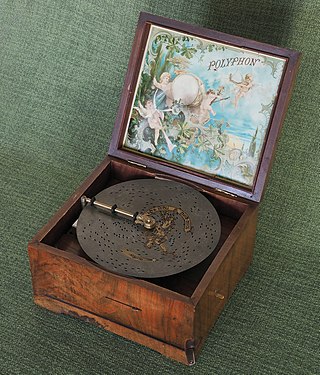
A music box or musical box is an automatic musical instrument in a box that produces musical notes by using a set of pins placed on a revolving cylinder or disc to pluck the tuned teeth of a steel comb. The popular device best known today as a "music box" developed from musical snuff boxes of the 18th century and were originally called carillons à musique. Some of the more complex boxes also contain a tiny drum and/or bells in addition to the metal comb.

A barrel organ is a French mechanical musical instrument consisting of bellows and one or more ranks of pipes housed in a case, usually of wood, and often highly decorated. The basic principle is the same as a traditional pipe organ, but rather than being played by an organist, the barrel organ is activated either by a person turning a crank, or by clockwork driven by weights or springs. The pieces of music are encoded onto wooden barrels, which are analogous to the keyboard of the traditional pipe organ. A person who plays a barrel organ is known as an organ grinder.
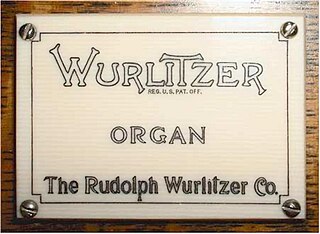
The Rudolph Wurlitzer Company, usually referred to as simply Wurlitzer, is an American company started in Cincinnati in 1853 by German immigrant (Franz) Rudolph Wurlitzer. The company initially imported stringed, woodwind and brass instruments from Germany for resale in the United States. Wurlitzer enjoyed initial success, largely due to defense contracts to provide musical instruments to the U.S. military. In 1880, the company began manufacturing pianos and eventually relocated to North Tonawanda, New York. It quickly expanded to make band organs, orchestrions, player pianos and pipe or theatre organs popular in theatres during the days of silent movies.

Orchestrion is a generic name for a machine that plays music and is designed to sound like an orchestra or band. Orchestrions may be operated by means of a large pinned cylinder or by a music roll and less commonly book music. The sound is usually produced by pipes, though they will be voiced differently from those found in a pipe organ, as well as percussion instruments. Many orchestrions contain a piano as well. At the Musical Museum in Brentford, London England, examples may be seen and heard of several of the instrument types described below.
Carl Frei was a German organ builder, composer and music arranger who founded a company that manufactured fairground and street organs.

M. Welte & Sons, Freiburg and New York was a manufacturer of orchestrions, organs and reproducing pianos, established in Vöhrenbach by Michael Welte (1807–1880) in 1832.

A street organ played by an organ grinder is a French automatic mechanical pneumatic organ designed to be mobile enough to play its music in the street. The two most commonly seen types are the smaller German and the larger Dutch street organ.
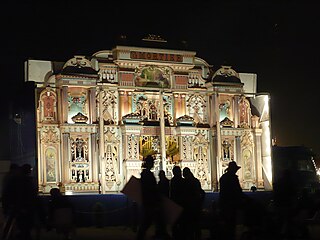
A dance organ is a French mechanical organ designed to be used in a dance hall or ballroom. Originated and popularized in Paris, it is intended for use indoors as dance organs tend to be quieter than the similar fairground organ.
A mechanical organ is an organ that is self-playing, rather than played by a musician. For example, the barrel organ is activated either by a person turning a crank, or by clockwork driven by weights or springs.
Gavioli & Cie were a Franco–Italian organ builder company that manufactured fairground organs in both Italy and later France.
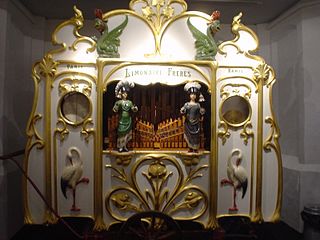
Limonaire Frères were an amusement ride, street organ and fairground organ builder, based in Paris, France, during the 19th and early 20th century.

The North Tonawanda Barrel Organ Factory was a street organ manufacturing company and building, located in North Tonawanda, New York. Started by expatriate German Eugene de Kleist with backing from Allan Herschell, the company was later purchased by the Wurlitzer company.
Baron Frederick Joseph Eugene de Kleist, was a pioneering German organ builder, who in founding the North Tonawanda Barrel Organ Factory, started the American style of Band organs.
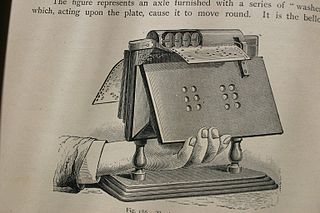
The Organette was a mechanical free-reed programmable (automatic) musical instrument first manufactured in the late 1870s by several companies such as John McTammany of Cambridge, Massachusetts, the Autophone Company of Ithaca, New York, the Automatic Organ Co of Boston, Massachusetts, E.P. Needham & Sons of New York City, J.M. Draper of Blackburn, England, Paul Ehrlich & Co. of Leipzig, Germany, and The Mechanical Orguinette Co. of New York, NY as well as other manufacturers worldwide.
Traditional French musical instruments, known as instruments traditionnels in French, are musical instruments used in the traditional folk music of France. They comprise a range of string, wind, and percussion instruments.


















